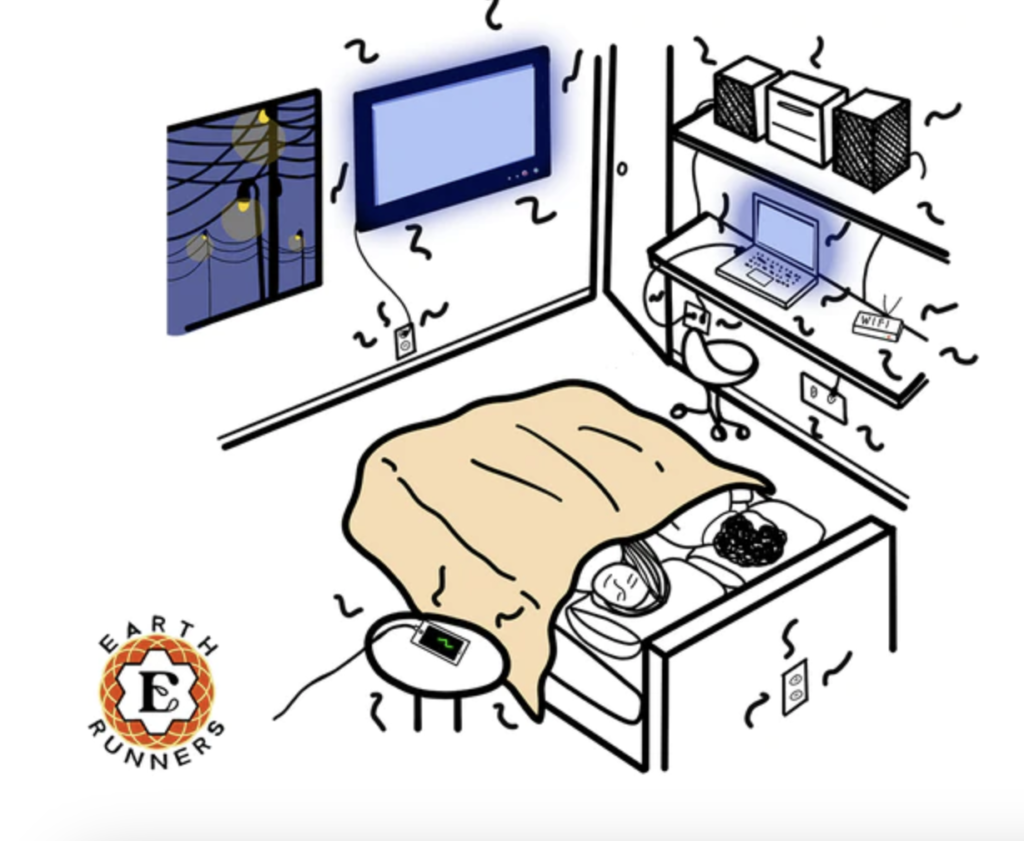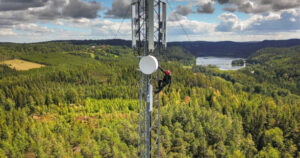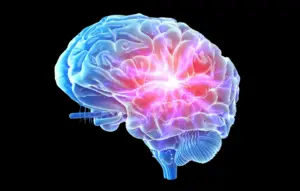Sleep is one of the most critical yet misunderstood components of good health. We’ve been taught to think about food, exercise, and stress management as pillars of wellness, but sleep is often taken for granted. When our rest is disrupted, we’re quick to look at surface-level factors: too much caffeine, inconsistent sleep routines, or late-night screen time. Yet, there’s an invisible factor that modern life has introduced—a hidden disruptor called electromagnetic fields, or EMFs. EMFs come from nearly every piece of technology in our lives, from our cell phones and Wi-Fi routers to laptops and household appliances. With this constant exposure, the question arises: could these unseen fields be silently affecting the quality of our sleep?
In this article, we’ll explore what EMFs are, how they interfere with our natural sleep processes, and most importantly, what steps we can take to improve sleep quality in a world brimming with wireless signals. With scientific insights, practical tips, and links to studies, we’ll leave no stone unturned.
What Are EMFs, and Why Should We Care?

EMFs are invisible energy waves emitted from electrical and wireless devices. These fields fall on a spectrum from extremely low-frequency (ELF) EMFs, like those generated by power lines, to higher-frequency radiofrequency (RF) EMFs, which are emitted by wireless devices such as cell phones, Wi-Fi routers, and microwaves. High-frequency EMFs include X-rays and gamma rays, though these are outside the scope of everyday, non-ionizing EMF exposure.
Why should we care? Because we are, on average, exposed to EMFs 24 hours a day. Many of us sleep with our cell phones next to our beds, keep Wi-Fi routers running overnight, and live in homes filled with “smart” devices that communicate wirelessly. This cumulative exposure is significant because, while low-level exposure might seem harmless, continuous and high-frequency exposure can potentially have physiological effects, particularly on our sleep patterns and overall health.
EMFs and Melatonin Suppression: The Sleep Disruptor
The Science of Melatonin
Melatonin is often called the “sleep hormone” because of its role in helping us fall asleep and stay asleep. It is produced by the pineal gland in response to darkness, and it helps regulate our circadian rhythm, or internal clock. However, EMFs can disrupt melatonin production, which may have downstream effects on the quality and depth of our sleep.
Studies have found that even low-level EMF exposure could disrupt melatonin synthesis in people, leading to issues in their sleep-wake cycles. In another study, published in the Journal of Pineal Research, researchers found that EMF exposure at work led to decreased melatonin levels in individuals, pointing toward EMFs as a factor that could interfere with sleep health.
Because melatonin is not only a sleep regulator but also a powerful antioxidant, reduced production means reduced cellular repair and increased vulnerability to oxidative stress. Over time, suppressed melatonin levels can also disrupt immune function and increase susceptibility to illnesses. So, when EMFs interfere with melatonin, they don’t just compromise our sleep; they impact broader aspects of our health.
EMF Effects on Brainwave Activity and Sleep Cycles
Sleep quality relies on a balanced cycle of different sleep stages, including light sleep, deep sleep, and REM (rapid eye movement) sleep. EMFs appear to have the ability to alter brainwave patterns, particularly by interfering with delta waves, which are crucial for deep, restorative sleep.
A study published in Bio Electro Magnetics explored how frequencies like the 900 MHz band used in cell phones impacted the brain’s EEG (electroencephalogram) readings during sleep. The study showed that exposure to these frequencies not only led to lighter sleep but also increased the frequency of wakefulness during the night. This effect on brainwave activity ultimately reduces the quality of sleep, as we need sufficient time in both deep and REM stages to feel rested and restored.
Interruption of these brainwave patterns means less restorative sleep, which over time can accumulate and lead to cognitive decline, emotional imbalance, and impaired physical recovery. If you often wake up feeling groggy or unfocused, EMFs could be a factor worth considering.
The Role of Oxidative Stress in EMF-Induced Sleep Disruption
Oxidative stress is a physiological state where the balance between free radicals (unstable molecules) and antioxidants in the body is disturbed. This imbalance leads to cellular damage and inflammation. Research indicates that EMFs, particularly RF radiation, can induce oxidative stress in the body, adding an extra layer of stress that can interfere with sleep quality and health.
A study published in Environmental Health Perspectives found that prolonged EMF exposure increased levels of reactive oxygen species (ROS), leading to oxidative stress and potential cellular damage. At night, our bodies rely on antioxidants to repair and regenerate cells. When oxidative stress is high, the body’s resources are stretched thin, compromising the body’s ability to enter and sustain deep sleep. This cumulative damage may go unnoticed initially but can contribute to poor immune health and faster aging over time.
Oxidative stress doesn’t just rob us of sleep quality; it can also degrade our overall energy levels, mood, and physical resilience. This stress impacts various systems in the body, from immunity to cognitive function, creating a cascade of issues that can make everyday life feel more draining and challenging.
Circadian Rhythm Disruption: EMFs as “Artificial Daylight”
The body’s internal clock, or circadian rhythm, is a sophisticated timing system regulated by environmental cues. When these cues are disrupted, our body’s natural sleep-wake cycle can go off track. While light exposure is the most well-known circadian disruptor, EMFs can also influence this biological clock.
A study from the Journal of Pineal Research showed that artificial EMFs could mimic signals that confuse the body into interpreting them as daytime cues. When we are exposed to EMFs during the night, our bodies may interpret these signals as “artificial daylight,” resulting in reduced melatonin levels and delayed sleep onset. For those already struggling with insomnia or sleep disturbances, this added disruption can be especially problematic.
Circadian misalignment has been associated with a range of health issues, from mood disorders and metabolic dysfunction to increased risk of chronic disease. So, while EMFs might not seem as impactful as a cup of coffee before bed, their ability to interfere with our circadian rhythm is real and should be taken seriously.
Dirty Electricity and the Bedroom Environment
Another concept worth understanding is “dirty electricity.” Unlike stable currents, dirty electricity involves erratic spikes in electrical flow caused by devices that draw fluctuating power, like computers and dimmer switches. These surges can create potent EMFs, adding a layer of interference to your living space.
A study from Liberty University found that individuals living in dirty electricity environments experienced more difficulty with sleep onset and maintenance. For those seeking high-quality rest, reducing the number of electronics in the bedroom and considering dirty electricity filters may provide noticeable improvements in sleep.

Image Source: EarthRunners
Practical Steps to Reduce EMF Exposure in the Bedroom
Now that we understand the science, let’s discuss actionable ways to reduce EMF exposure and improve sleep quality. While it’s impossible to eliminate EMFs completely, we can take steps to minimize exposure in the bedroom:
Turn Off Wi-Fi at Night: A simple timer can help automate this process. By disconnecting Wi-Fi during sleeping hours, you reduce RF exposure significantly.
Use Airplane Mode: Switching your phone to airplane mode reduces EMF emission while still allowing the device to function as an alarm clock. Place it on a nightstand rather than under your pillow to keep it a few feet away.

Save 25% on Aires Tech with code “kyletothemoon” Invest in EMF Neutralizers: For those serious about creating a low-EMF sleep environment, consider investing in EMF-neutralizing technology from companies like Aires Tech. These devices work by restructuring the EMF waves to make them more biocompatible, reducing potential interference with your body’s natural systems, including melatonin production and circadian rhythms.
Use Hard-Wired Connections: Where possible, replace wireless connections with Ethernet cables, particularly in the home office, reducing the need for Wi-Fi.
Invest in an EMF Meter: These devices can help you identify EMF “hot spots” in your home, allowing you to rearrange or unplug items as needed.
Adopt Grounding Practices: Spending time outside on natural surfaces like grass or sand allows the body to release positive charges, alleviating some of the effects of EMF exposure.
Create a Low-EMF Bedroom: Keep electronic devices away from the bed and unplug them when not in use, even chargers and lamps, to minimize the electrical field exposure around your sleep area.
Real-Life Experiences with EMF Sensitivity and Sleep
Electrohypersensitivity (EHS) is a condition where individuals experience adverse reactions to EMF exposure. Symptoms often include headaches, insomnia, and cognitive issues, and these individuals may find their sleep particularly vulnerable to EMF exposure.
A case study published in Electromagnetic Biology and Medicine found that individuals with EHS who spent time in a low-EMF environment reported significant improvements in sleep quality and reduction of symptoms (source). Even for those without diagnosed EHS, reducing EMF exposure may yield surprising improvements in sleep quality and daytime focus.
The Future of EMF Awareness and Sleep Research
As more studies highlight the potential impacts of EMF exposure on sleep, awareness is likely to grow. In some countries, such as Switzerland and Italy, precautionary EMF guidelines and reduced exposure limits are already in place. Hospitals, wellness centers, and even luxury hotels are beginning to create EMF-free zones for sensitive individuals.
For personal spaces, understanding and managing EMF exposure can empower us to take control of our sleep environment. The ability to rest in an EMF-minimal environment may eventually become a sought-after feature in new homes and rental properties. Until then, practicing conscious EMF management at home can be an invaluable tool for promoting better sleep.
Conclusion: Embracing Low-EMF Living for Optimal Sleep
EMFs are inescapable in our modern world, but their impact on sleep shouldn’t be ignored. As we’ve explored, EMFs can influence everything from melatonin production and brainwave patterns to oxidative stress and circadian rhythm alignment. Taking small steps to reduce exposure, especially in the bedroom, could have a profound effect on our sleep quality and overall health.
In the quest for better rest, evaluating and minimizing EMF exposure might just be the secret ingredient. Tonight, consider trying a few of these changes, like turning off your Wi-Fi, grounding your space, or adding an EMF shielding device. The peace and deep, uninterrupted sleep that follow may be just what you’ve been missing.







